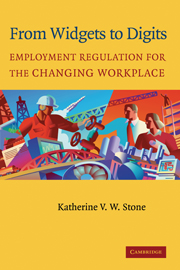Book contents
- Frontmatter
- Contents
- Preface
- Introduction
- PART I LABOR RELATIONS REGIMES OF THE PAST
- 1 Artisanal Production in the Nineteenth Century
- 2 The Labor System of the Industrial Era
- 3 From Scientific Management to Internal Labor Markets
- PART II THE DIGITAL WORKPLACE
- PART III IMPLICATIONS OF DIGITAL JOB STRUCTURES FOR LABOR AND EMPLOYMENT LAW
- PART IV SOCIAL JUSTICE IN THE DIGITAL ERA
- Summary and Conclusion
- Index
2 - The Labor System of the Industrial Era
Published online by Cambridge University Press: 14 January 2010
- Frontmatter
- Contents
- Preface
- Introduction
- PART I LABOR RELATIONS REGIMES OF THE PAST
- 1 Artisanal Production in the Nineteenth Century
- 2 The Labor System of the Industrial Era
- 3 From Scientific Management to Internal Labor Markets
- PART II THE DIGITAL WORKPLACE
- PART III IMPLICATIONS OF DIGITAL JOB STRUCTURES FOR LABOR AND EMPLOYMENT LAW
- PART IV SOCIAL JUSTICE IN THE DIGITAL ERA
- Summary and Conclusion
- Index
Summary
In the late nineteenth and early twentieth centuries, employers' widespread success in breaking the skilled workers' unions caused the entire artisanal system of work organization, wage determination, and training to collapse. As a result, employers had to construct a new labor system. They were determined to build a new system in which production was not dependent upon the knowledge and cooperation of skilled workers. The labor-saving and skill-saving innovations of the preceding decades partially freed employers from the stranglehold of the craft workers, but new technology alone could not create a new labor system. Employers still had to adapt the jobs to the new technology and had to prevent ineptitude, neglect, and sabotage of the new machines. This meant training workers to operate the machines and to ensure that the machines were properly tended, coordinated, and maintained. In addition, employers had to motivate workers to perform the newly deskilled jobs efficiently, rather than begrudgingly. That is, they had to prevent deliberate restriction of output and build a spirit of cooperation. And finally, they had to establish mechanisms and practices that would ensure that employers, rather than workers, maintained lasting control over the pace and quality of production.
The Twentieth-Century “Labor Problem”
After the skilled workers' unions were broken and their skills downgraded, employers found themselves with a crisis of discipline and morale on the shop floor. In the artisanal era, skilled workers saw themselves as partners in production, so that the problem of motivation did not arise. The wage structure and the inside contracting system gave skilled workers the sense that they were working for themselves.
- Type
- Chapter
- Information
- From Widgets to DigitsEmployment Regulation for the Changing Workplace, pp. 27 - 50Publisher: Cambridge University PressPrint publication year: 2004

